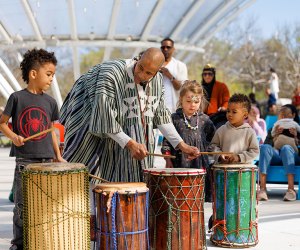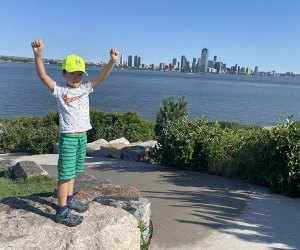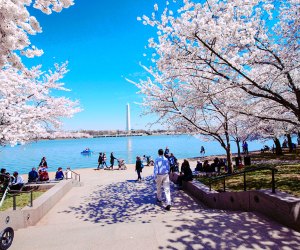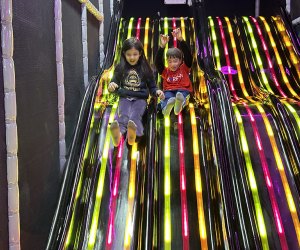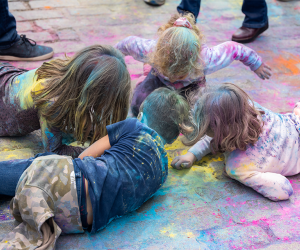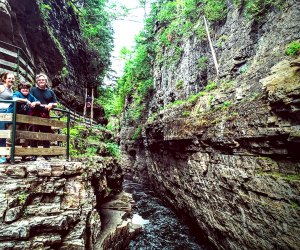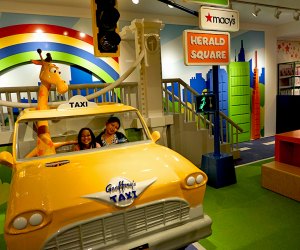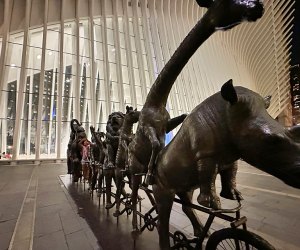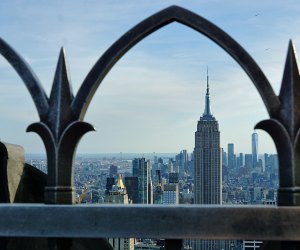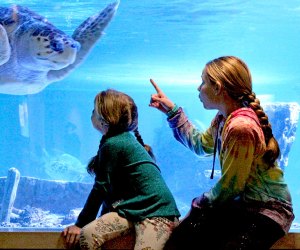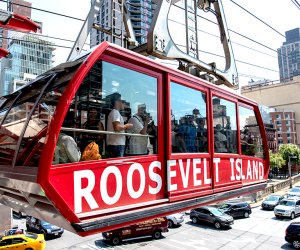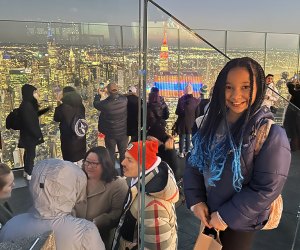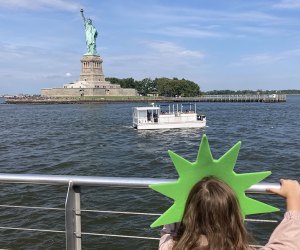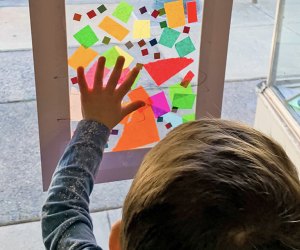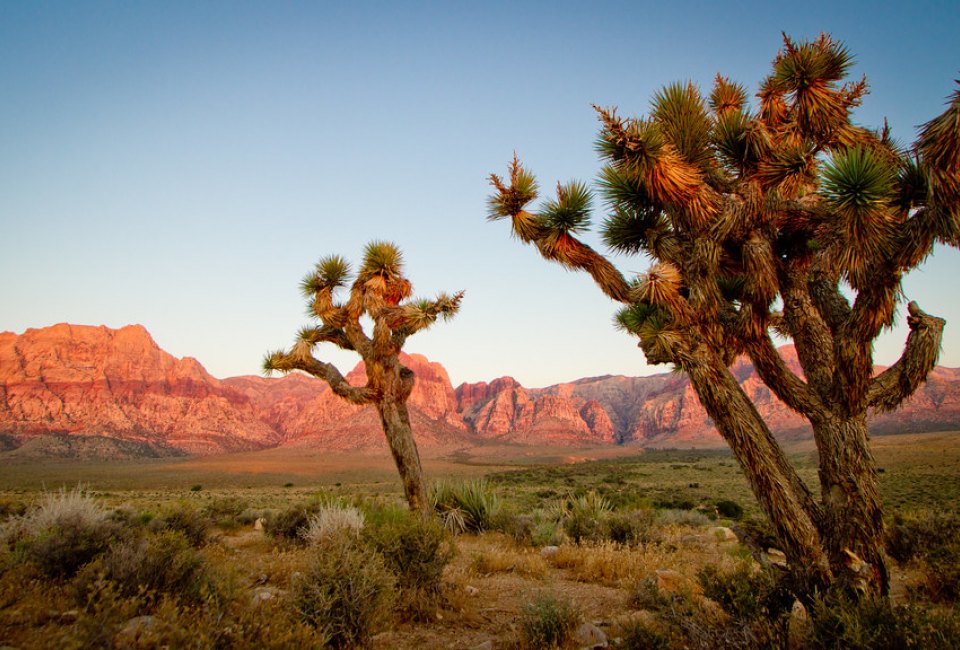Things To Do In Joshua Tree: 12 Things Not To Miss with Kids in this Desert National Park
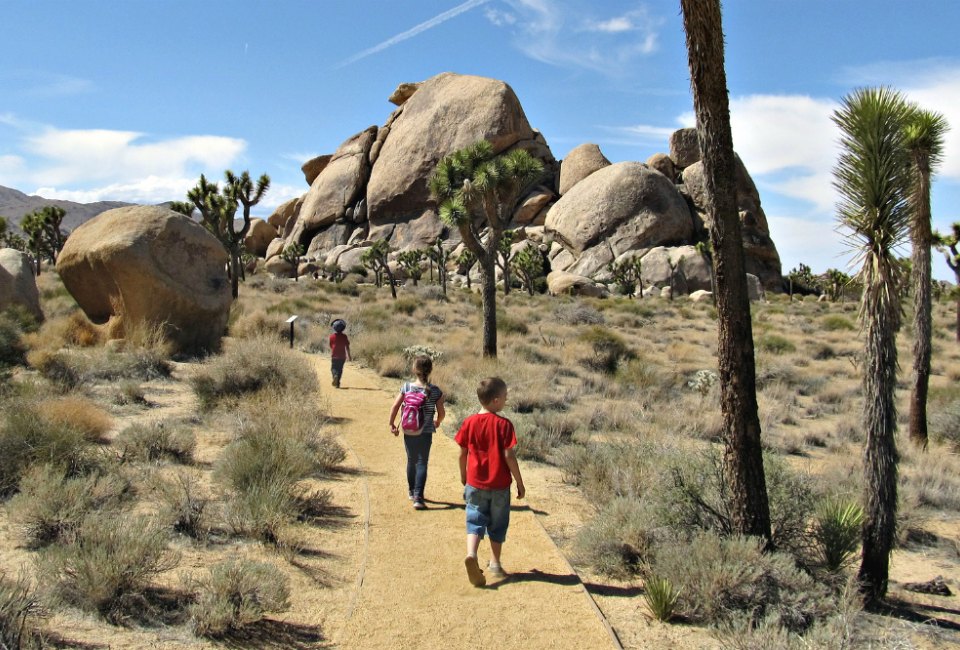
Visiting Joshua Tree National Park is an otherworldly experience: groves of twisted trees and giant boulders create enchanting settings so unique, you might think you have stepped into a fairy tale—or landed on an alien planet. Approximately a two-hour drive from Los Angeles and a stone's throw from Palm Springs, this park is great for a family camping adventure or just a day hike because it captures everyone’s imagination. Stroller-friendly trails make it a great option for little trekkers, as do several walks easy enough for young kids (or tired grown-ups) to maneuver. But teens and tweens who never tire won't run out of rocks and boulders to climb over.
Read on to get the latest information on what's open, what to see, and how to explore this spectacular local national park. Spending the night? Check out our 10 Favorite Joshua Tree Airbnbs, Hotels, and Campgrounds for Families.
OUR LATEST VIDEOS
What To Bring To Explore Joshua Tree National Park
Like any desert trip, Joshua Tree National Park requires preparation, as the weather and the elements can be harsh. Summer months (June through September) are when temperatures can be well above 100 degrees during the day. Any other month of the year is usually pleasant by day, but nights get pretty cold, especially at the park's higher altitudes. Bringing layers for variable weather is a must.
There are no shops or concessions inside the park, so it's important to pack all the food and water you need, and then some. Dry heat can make everyone thirstier than usual, so bring lots of water and fluids to keep the whole family hydrated. Hiking, climbing, and jumping make the kids hungrier, too, so it’s a good idea to stock up on lots of snacks. Sturdy shoes, a change of clothes, hats, sunscreen, wipes, and a first aid kit are essential, even if visiting for just a few hours. Have a baby or toddler? A backpack carrier is mandatory if you plan to get off the beaten path for any significant hiking.
Bringing an extra phone charger is a smart move, too, but be warned that most areas in Joshua Tree have no cell phone or data service, so you’ll be out of touch once you’re in the park. Plan on posting all those pictures when you exit and work out an alternative way to communicate if your party splits up; walkie-talkies are great.
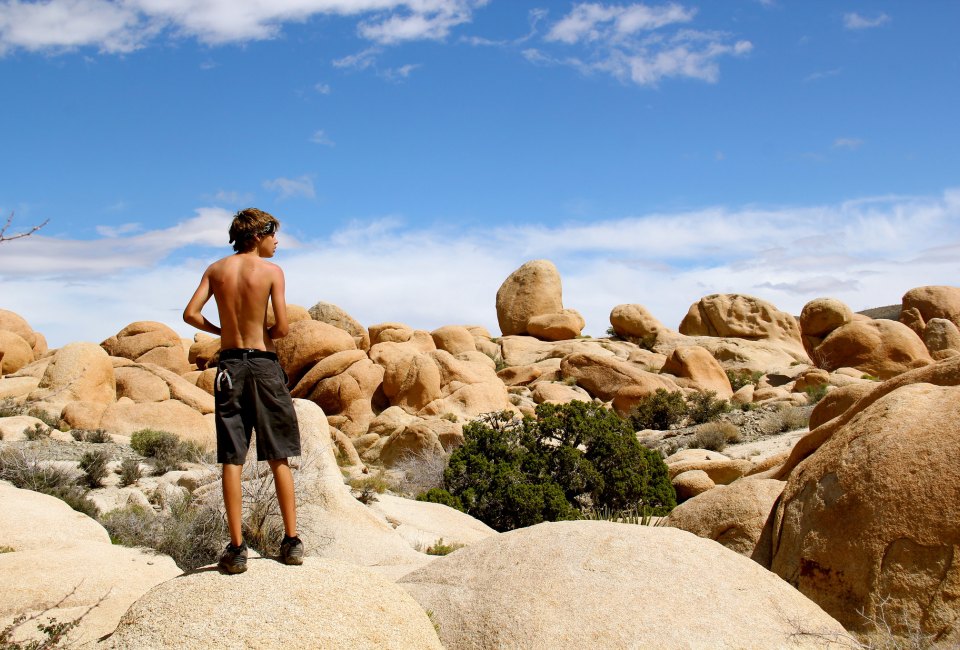
Hike the Arch Rock Trail. Photo by David Fulmer/CC BY 2.0
Like the Scouts, Be Prepared
Most importantly, use an old-fashioned map and rely on your Boy or Girl Scouts skills when navigating within the park. GPS directions often try to route drivers onto backcountry roads with ruts or soft sand that may be impassable for vehicles.
For happy campers wanting to spend the night, there are several options. Some are first-come, first-served, but the most family-friendly campgrounds—Black Rock, Indian Cove, and Cottonwood Springs—do take reservations in advance (fee is $20 per night). Black Rock has water, flush toilets, and a dump station, and is a close enough drive to town to pick up more firewood for the barbecue. If camping is not your thing, there are plenty of Airbnb rentals, B&Bs, and some fun motels and cool resorts near the park, including the Joshua Tree Inn and 29 Palms Inn.
Admission to the park is $30 per car, is good for seven consecutive days, and includes the all-important map. (You can purchase a vehicle pass online, to minimize contact when entering the park.) There are three entrances to the park: the west entrance (near Joshua Tree Village) and the north entrance (in the town of Twentynine Palms) both located on the northern end of the park and the south entrance near Cottonwood Village with the closest access to Highway I-10. If spending only one day, enter through the west entrance and exit through the south so you can drive the entire length of the park.
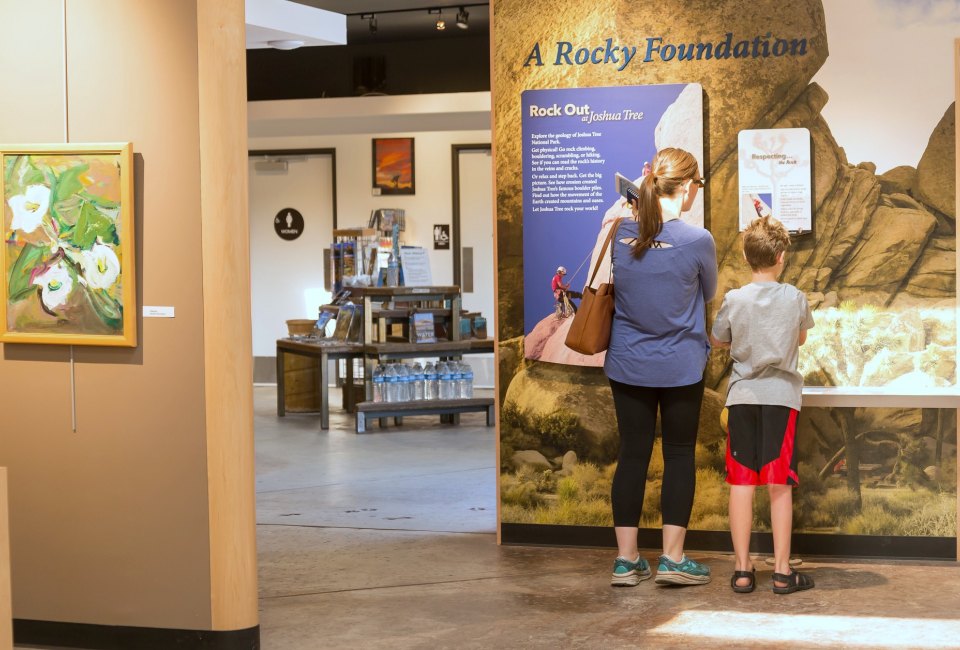
Exhibits are closed, but information is available at the Joshua Tree Visitor Center. Photo by Alison Taggart-Barone/NPS
The three visitor centers, located just outside the park, have modern toilets, water, and bookstores where you can get passes without waiting in line at the kiosks at the park entrance. Here, kids can pick up a Junior Ranger booklet about Joshua Tree and receive an official Junior Ranger badge upon studying and completing activities at the park. They can also get the memorable National Park Passport, which is just like a real passport but possibly more fun (plus easier to get and it never expires). Your junior rangers can collect cancellation stamps and commemorative stickers at every US national park they visit for the rest of their lives.
Ready now? Grab those passports, pop a certain 80s album in the CD player, and venture into this spellbinding park. Happy trails!
RELATED: Visit the Old West Brady Bunch Style in a Hollywood Western Town
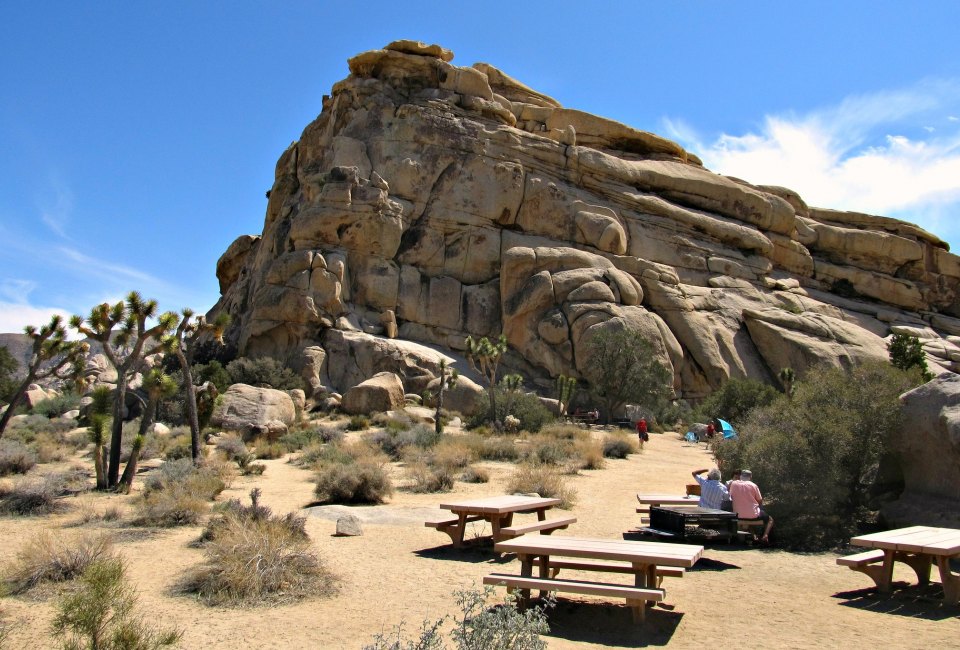
Stop for a picnic before exploring Hidden Valley. Photo by Ken Lund/CC BY 2.0
The Top 12 Must-Do and Must-See Things in Joshua Tree
1) Wander and Picnic at Hidden Valley
Located not far from the west and north entrances, the 1-mile hiking path weaves through and over boulders, offering breathtaking views of Hidden Valley and some climbing fun for kids. Picnic tables near the parking lot are the perfect spot to fuel up for the day.
2) Spot Sheep and Deer at Barker Dam
This 1.1-mile loop offers a bigger variety of landscapes to observe and takes visitors to one of the only places to see water in Joshua Tree. Keep your eyes peeled for some desert bighorn sheep and mule deer, which often come down to the water to drink.
3) Tour the Keys Ranch
The Barker Dam trail leads through some of the old Keys Ranch lands. The ranger-led Keys Ranch Tour (tickets are available at the Oasis Visitor Center, and must be reserved and purchased in advance) allows visitors to walk up to the outbuildings and peek in the windows of the 19th-century farmhouse. Don’t miss the petroglyphs on the rocks at the back end of the loop.
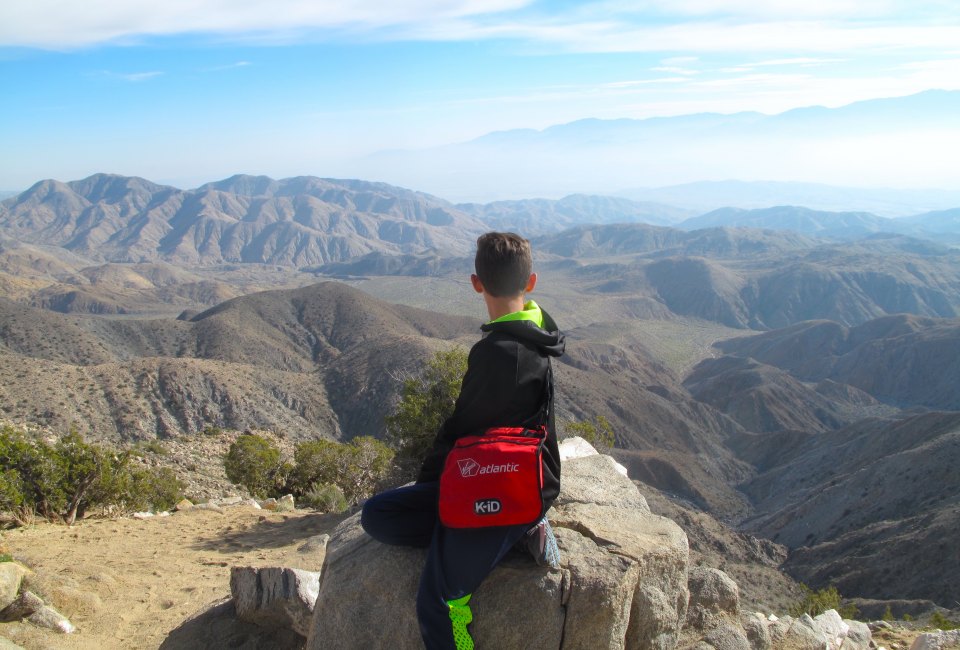
Take in the San Andres Fault at Keys View. Photo by Mommy Poppins
4) Gaze at the San Andreas Fault
From Barker Dam, a 20-minute (one way) scenic detour leads to the highest viewpoint in Joshua Tree. Keys View provides sprawling panoramas of mesas, mountains, and of the actual line of the infamous San Andreas Fault. Get the selfie stick ready!
5) Follow the Informative Trail at Cap Rock
On the way back from Keys View Road, stretch your legs at this short, 0.3-mile loop that winds through Joshua tree woodland and between spectacular rock formations. This crushed stone trail is lined with many informative signs describing the variety of desert plants and shrubs. Enjoy your lunch at the picnic tables before leaving for the next adventure.
6) Find the Ryan House and the Lost Horse Well
An easy one-mile out-and-back hike on a flat trail leads to the remains of Ryan Ranch, which was established by a family of settlers in 1896. Explore the old adobe brick buildings and look for the broken windmill and old fencing.
RELATED: A Visit to Death Valley National Park with Kids
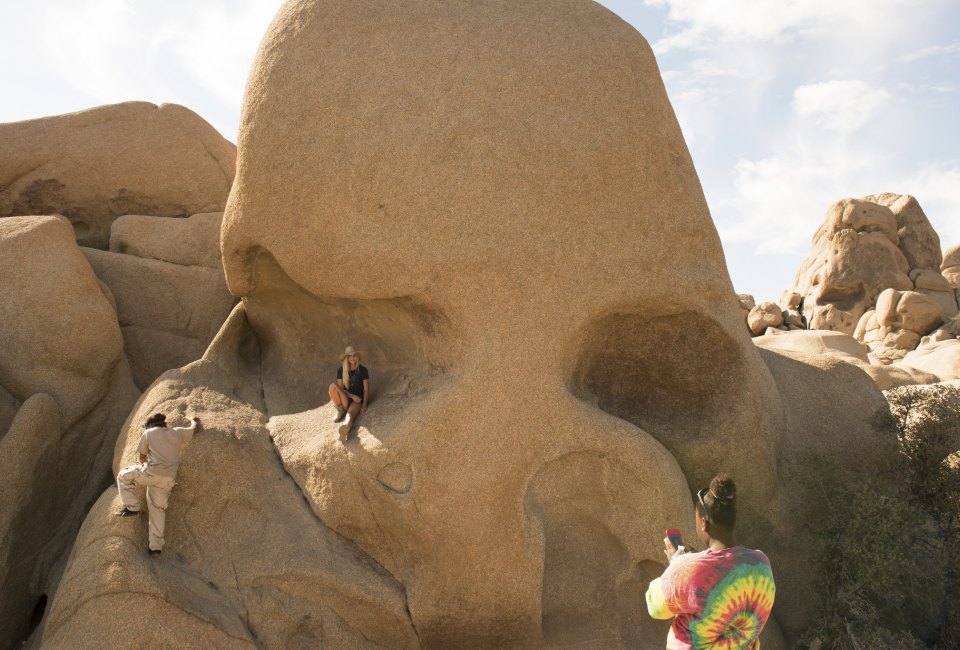
Scrambling over Skull Rock for the perfect shot. Photo by Hannah Schwalbe/NPS
7) Scramble Over Rocks at Jumbo Rocks and Skull Rock
With boulder piles and a giant rock shaped like a skull, Jumbo Rocks and Skull Rock are the closest thing to a playground you'll find here. Kids get a kick out of jumping on them and pretending to be Jack Sparrow. From here, there’s an easy 1.7-mile nature trail worth a visit.
8) Listen to the Chatty Birds at Oasis of Mara
Adjacent to the Oasis Visitor Center, this short, paved trail (0.5 miles) meanders through playas dotted with honey mesquite. It’s also the best place to observe wildlife, especially birds. Kids will definitely be fascinated to learn how people have used the fresh water and natural resources present here since time immemorial.
9) Smell the Flowers at Indian Cove
Covered by Mojave yuccas and colorful shrubs that bloom in the spring, Indian Cove is a charming, secluded area only accessible from the Twentynine Palms Highway. While hiking the short .6 loop nature trail, be on the lookout for the elusive desert tortoise and roadrunners. Have dinner at the nearby picnic tables.
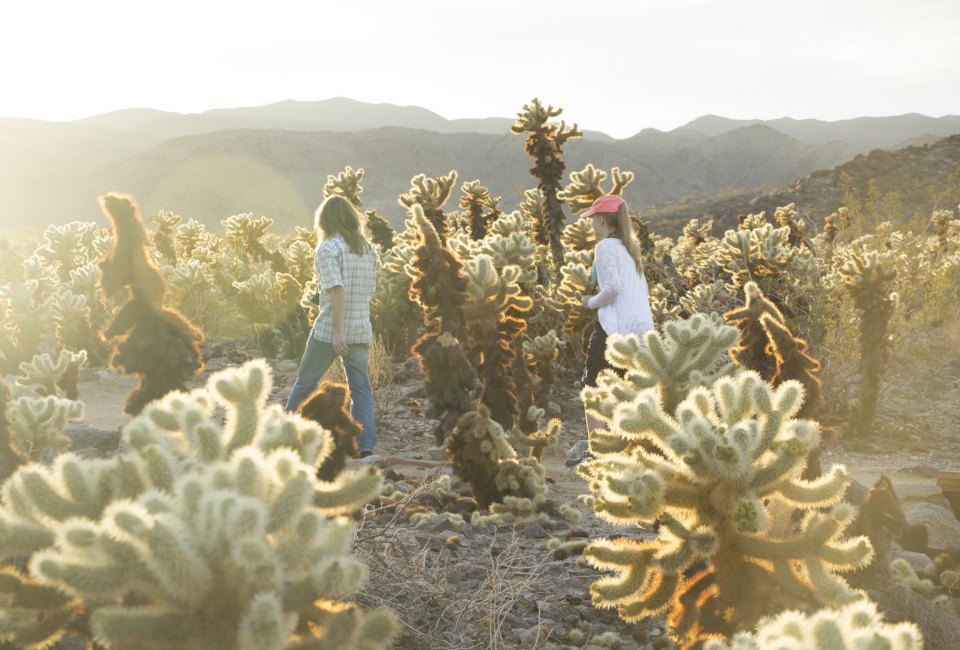
The sun sinks low at the Cholla Cactus Garden. Photo by Brad Sutton/NPS
10) Watch the Sunset at Cholla Cactus Garden
Located closer to the southern end of the park, Cholla Cactus Garden features thousands of beautiful cacti that look truly magical thanks to their iridescent glow when dusk sets in. Stick to the path and keep your little ones close, as the cactus needles are long, sharp, and cover the ground even when you don’t notice them.
11) Walk Through the Lost Palm Oasis
Before exiting the park, if it’s still light out, head off on the 1-mile hike near the Lost Palm Oasis, one of Joshua Tree’s most beautiful spots. Nestled between mountains, the oasis boasts huge native California fan palm trees and sandy washes descending into a canyon.
12) Nerd Out at the Bajada
A short but sturdy footbridge over a creek bed leads to the beginning of this half-mile-long loop peppered with exhibits about the area and the variety of Colorado desert plants and wildflowers growing here. After this trail, you’ll be an expert in flora. Stop and relax at one of the several benches before heading home.








